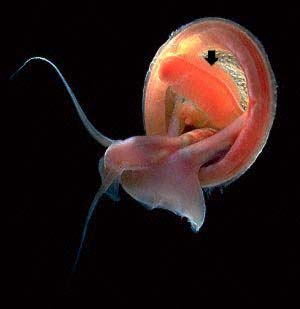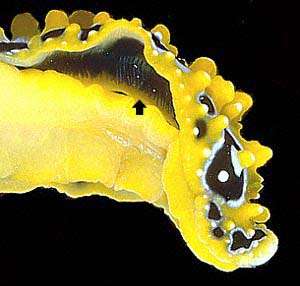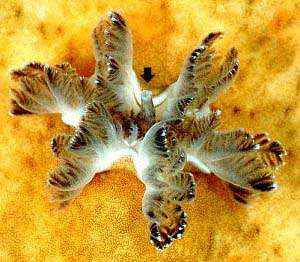
Torsion and detorsion
PHOTO
UPPER: The primitive marine snail Phenacolepas, with its cap-shaped shell folded back to show its mantle cavity. Note pair of large shell muscles and single large gill (arrow).
LOWER RIGHT: Gills of the dorid nudibranch Platydoris showing the anal papillae (arrow) intimately connected.
LOWER LEFT: Part of the left side of the phyllidiid Phyllidia ocellata showing the secondary gills (arrow).
PHOTOS: Bill Rudman.
RELATED TOPIC
Detorsion - how snails became sea slugs
The evolution of the opisthobranch body plan is basically a story of how these animals "detorted”. And to understand what that means we need to know what “torsion” is. In simple terms, the primitive gastropod snail has twisted its body so that the posterior end, with the anus, reproductive openings, kidney openings and gills, comes to sit above the head facing forwards. Why this occurred has been debated for over a century. Clearly it is related to the evolution of a shell with only a single “mouth” or opening, but which came first is still being debated. The photo of Phenacolepas, a relatively primitive marine snail, with a cap-shaped shell, illustrates the main features of a “torted” mollusc. The mantle cavity, enclosed by the shell sits above the head, and faces forwards, as do the anus and all the other openings situated in the mantle cavity. Torsion, or twisting, often lead to an assymetry in the mantle cavity organs, the loss of one of a set of paired gills being one of the most obvious examples. In Phenacolepas, only one gill remains.
The story of opisthobranch evolution is essentially the history of detorsion and the loss of the shell. In the cephalaspid Bubble Shells and the aplysiid Sea Hares there are many examples showing the gradual reduction in the size and importance of the shell, and the gradual rotation backwards, down the right hand side, of the mantle cavity opening and its associated organs - the gill, anus, reproductive openings etc. Another group of sea slugs, the notaspideans (pleurobranchs etc), are also called the “side-gilled” slugs because their gills stopped on the right side of the body during their evolution. The photo of Berthella martensi with an autotomised mantle skirt shows the gill on the right side of the body. Even in the true nudibranchs, which no longer have a shell or a mantle cavity, the close relationship of these former mantle cavity structures can be seen in the inseparable partnership between the anal papillae and the dorid gill circlet as seen in Platydoris.
Some gills in nudibranchs are clearly not the original gills but are secondary structures. In Phyllidia there are secondary gills along each side of the body between the mantle edge and the foot. In aeolids and tritoniids the original gill is lost and secondary papillae or cerata have evolved to take their place.
LOWER RIGHT: Gills of the dorid nudibranch Platydoris showing the anal papillae (arrow) intimately connected.
LOWER LEFT: Part of the left side of the phyllidiid Phyllidia ocellata showing the secondary gills (arrow).
PHOTOS: Bill Rudman.


Rudman, W.B., 1998 (October 28) Torsion and detorsion. [In] Sea Slug Forum. Australian Museum, Sydney. Available from http://www.seaslugforum.net/factsheet/torsion
Related messages
-
Gastropod torsion
From: Manjit Hansra, March 19, 1999 -
Torsion & nudibranch gills
From: Hilda Norris, October 28, 1998
